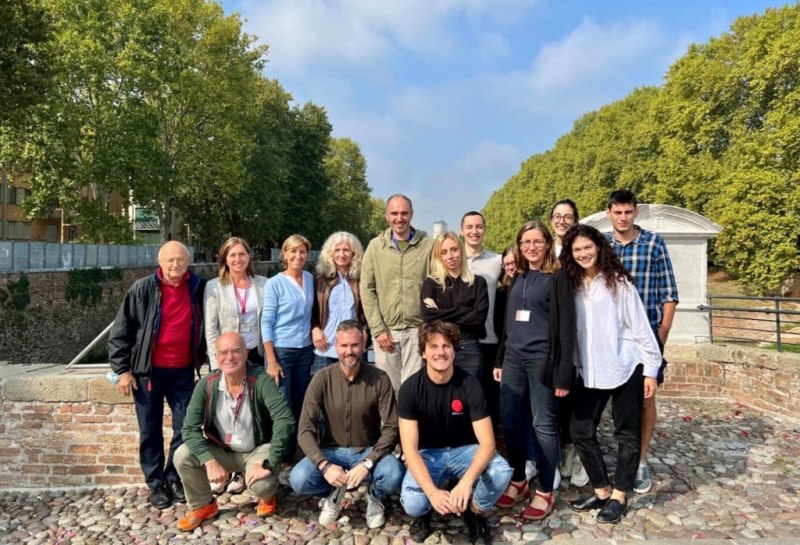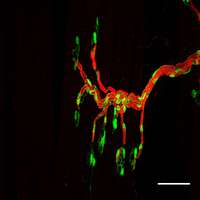
Neurotoxins, Neuroparalysis and Neuroregeneration Lab


We study the unique remodelling and regenerative capabilities of the neuromuscular junction (NMJ) to discover the signals exchanged among its cellular components (the motor axon terminal, perisynaptic Schwann cells and the muscle) leading to a successful functional recovery after different forms of nerve injury. Among them, degeneration and/or paralysis induced by mechanical traumas, autoimmune attacks, and presynaptic animal or bacterial neurotoxins provide good models to discover:
- the signals activating the muscle and perisynaptic Schwann cells to promote NMJ rescue
- the back signals stimulating the recovery of function of paralysed motor axon terminals
- the molecular determinants of NMJ plasticity in health and disease
This approach provides a source of candidate pro-regenerative molecules and pathways to be tested also in chronic neurodegenerative contexts such as Amyotrophic lateral sclerosis (ALS).
We study tetanus and botulinum neurotoxins. These are the most toxic substances discovered so far, so potent that a few nanograms can be lethal for a human. At the same time, for their potency and specificity botulinum neurotoxins have turned to be very safe and effective drugs for several neurological syndromes. Our research aims at understanding the mechanism of action of these toxins at cellular and systemic levels with multiple goals:
- to elucidate the molecular pathogenesis of tetanus and botulism
- to identify novel countermeasures to prevent or treat human tetanus and botulism
- to discover novel strategies to improve the therapeutic use of botulinum neurotoxins
People
Faculty
- Ornella ROSSETTO - Associate Professor
- Aram MEGIGHIAN - Associate Professor
- Michela RIGONI - Associate Professor
- Marco PIRAZZINI - Assistant Professor
- Cesare MONTECUCCO - Professor Emeritus
Lab Members
- Samuele NEGRO - Young PI
- Federico FABRIS Post-doctoral fellow
- Sandy RICHTER Post-doctoral fellow
- Marika TONELLATO PhD student
- Stefano AMORETTI PhD student
- Giorgia SCHIAVONE PhD student
- Marica ZAINOTTO PhD student
- Chiara BAGGIO Graduated student
- Chiara LAVITOLA Graduated student
- Morena SIMONATO - C.N.R. Senior Technician, Lab Manager
Five recent publications
- D'Este G, Fabris F, Stazi M, Baggio C, Simonato M, Megighian A, Rigoni M, Negro S, Montecucco C. Agonists of melatonin receptors strongly promote the functional recovery from the neuroparalysis induced by neurotoxic snakes. PLoS Negl Trop Dis. 2024 Jan 8;18(1):e0011825
- Rossetto O, Pirazzini M, Montecucco C. Three players in the 'toxic affair' between botulinum neurotoxin type A and neurons. Trends Neurosci. 2023 Sep;46(9):695-697
- Fabris F, Varani S, Tonellato M, Matak I, Šoštarić P, Meglić P, Caleo M, Megighian A, Rossetto O, Montecucco C, Pirazzini M. Facial neuromuscular junctions and brainstem nuclei are the target of tetanus neurotoxin in cephalic tetanus. JCI Insight. 2023 Jun 8;8(11):e166978
- Negro S, Lauria F, Stazi M, Tebaldi T, D'Este G, Pirazzini M, Megighian A, Lessi F, Mazzanti CM, Sales G, Romualdi C, Fillo S, Lista F, Sleigh JN, Tosolini AP, Schiavo G, Viero G, Rigoni M. Hydrogen peroxide induced by nerve injury promotes axon regeneration via connective tissue growth factor. Acta Neuropathol Commun. 2022 Dec 25;10(1):189
- Fabris F, Šoštarić P, Matak I, Binz T, Toffan A, Simonato M, Montecucco C, Pirazzini M, Rossetto O. Detection of VAMP Proteolysis by Tetanus and Botulinum Neurotoxin Type B In Vivo with a Cleavage-Specific Antibody. Int J Mol Sci. 2022 Apr 14;23(8):4355
- Pirazzini M, Grinzato A, Corti D, Barbieri S, Leka O, Vallese F, Tonellato M, Silacci-Fregni C, Piccoli L, Kandiah E, Schiavo G, Zanotti G, Lanzavecchia A, Montecucco C. Exceptionally potent human monoclonal antibodies are effective for prophylaxis and treatment of tetanus in mice. J Clin Invest. 2021 Nov15;131(22):e151676
- Stazi M, Negro S, Megighian A, D'Este G, Solimena M, Jockers R, Lista F, Montecucco C, Rigoni M. Melatonin promotes regeneration of injured motor axons via MT1 receptors. J Pineal Res. 2021 Jan;70(1):e12695
- Negro S, Lessi F, Duregotti E, Aretini P, La Ferla M, Franceschi S, Menicagli M, Bergamin E, Radice E, Thelen M, Megighian A, Pirazzini M, Mazzanti CM, Rigoni M, Montecucco C. CXCL12α/SDF-1 from perisynaptic Schwann cells promotes regeneration of injured motor axon terminals. EMBO Mol Med. 2017 Aug;9(8):1000-1010
- Pirazzini M, Rossetto O, Eleopra R, Montecucco C. Botulinum Neurotoxins: Biology, Pharmacology, and Toxicology. Pharmacol Rev. 2017 Apr;69(2):200-235
- Duregotti E, Negro S, Scorzeto M, Zornetta I, Dickinson BC, Chang CJ, Montecucco C, Rigoni M. Mitochondrial alarmins released by degenerating motor axon terminals activate perisynaptic Schwann cells. Proc Natl Acad Sci U S A. 2015 Feb 3;112(5):E497-505




